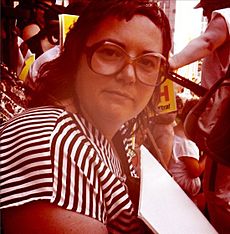Allyson Mitchell facts for kids
Quick facts for kids
Allyson Mitchell
|
|
|---|---|
 |
|
| Born | 1967 Scarborough ON
|
| Education | York University |
| Known for | sculptor, installation artist, and filmmaker |
Allyson Mitchell is a Canadian artist who lives in Toronto. She creates art mainly through sculpture, large art displays (called installations), and films. Her art often mixes ideas from feminism (which supports equal rights for women) with pop culture. She uses recycled fabrics and old crafts to explore how women and bodies are shown in today's world.
Throughout her career, Mitchell has looked at how society has been afraid of femininity and how history has shaped our views. She also explores topics like buying things, different kinds of love, body positivity, and cultural traditions. Her art is based on a special way of thinking called "Deep Lez," which combines older feminist ideas with newer ways of thinking about identity.
Mitchell works as a professor at York University in Toronto.
Contents
Early life and education
Allyson Mitchell studied at York University. She earned three degrees there:
- A Bachelor's degree in Women's Studies and English in 1995.
- A Master's degree in Women's Studies in 1998.
- A Ph.D. (a very high degree) in Women's Studies in 2006.
For her Ph.D., Mitchell wrote about how our body image changes in different situations.
Works
In 1996, Mitchell helped start an art group with Ruby Rowan and Mariko Tamaki. This group used performance art to promote body positivity.
In 2010, Mitchell also helped create the Feminist Art Gallery with Deirdre Logue. This gallery focuses on art by women and about feminist ideas.
One of her famous projects is Kill Joy's Kastle. For this, Mitchell created a special kind of haunted house. Her art is shown by Katherine Mulherin Contemporary Art.
Her artworks have been shown in many galleries and festivals. These include places in Canada, the US, and Europe. Some well-known places are the Tate Modern, the Textile Museum of Canada, and the Art Gallery of Ontario.
Ladies Sasquatch
Mitchell's Ladies Sasquatch is an ongoing art project. It features six large, mythical "she-beast" sculptures. These sculptures are made from fake fur and colorful fabrics. They can be as tall as eleven feet! The fuzzy, human-like creatures are shown sitting around a campfire in different poses. Mitchell has given each one a name, like Silverback, Tawny, and Maxy. They also have smaller, strange-looking "familiars" (animal companions) made of pink fur. Mitchell describes Lady Sasquatch as "your dream girl, only bigger and hairier."
A Girl's Journey Into the Well of Forbidden Knowledge
A Girl’s Journey into the Well of Forbidden Knowledge was an art display in 2010. It was shown at the Art Gallery of Ontario in Toronto. For this project, Mitchell recreated a reading room from the Lesbian Herstory Archives in Brooklyn.
Mitchell was inspired by her time at these Archives in New York. She wanted to bring women's history and culture to a wider audience. So, she turned the gallery space into a special library. One wall was covered with drawings that honored the books in the Archives. This artwork celebrated not only the Lesbian Herstory Archives but also all the feminist publishers, bookstores, and libraries that share women's stories. The drawings also remind us of how important physical books were for connecting communities, especially as many women's bookstores are disappearing in the digital age.
Kill Joy's Kastle
Kill Joy’s Kastle: A Lesbian Feminist Haunted House was a very large art project. It had many rooms and used different types of media. Allyson Mitchell and Deirdre Logue created it with over a hundred other artists and performers. Kill Joy’s Kastle was first shown in Toronto in 2013. It was also displayed in London, Los Angeles, and Philadelphia in the years that followed.
Themes
Deep Lez
Mitchell's art is deeply connected to ideas about feminism. In 2009, she wrote a statement about her approach called "Deep Lez I Statement." This way of thinking combines older feminist ideas with newer, more inclusive ways of thinking about identity.
Deep Lez tries to bring together many different histories and viewpoints. Mitchell describes it as an "experiment" and a "blend of theory and practice." It aims to understand and address past disagreements and forgotten stories within feminist and identity movements. Deep Lez guides Mitchell as an artist. It helps her explore how art and politics connect. It also looks at how modern movements can be more inclusive while still valuing important parts of past feminist ideas. Mitchell's art often uses public spaces to express these ideas.
Craft as Queer and Feminist Resistance
Allyson Mitchell is one of several artists who use crafts as a way to express protest and feminist ideas. Crafting, like sewing or knitting, has always been important in communities. Artists now use it to challenge old ideas about what is considered "high art" versus "craft," or male versus female.
Mitchell often uses textured fabrics in her work. She celebrates women's connections and feminism through these materials. Her art transforms spaces and creates a sense of power. Using craft in this way is part of a long history of feminist art. Many artists in the 1960s and 70s used craft to challenge traditional roles. They created "fiber art" or "soft sculpture" to bridge the gap between art and craft. Today, crafting is still seen as a way for some communities to express themselves and survive. Mitchell's work shows this by using textiles to create new worlds and challenge traditional ideas about gender.
Collections
- Agnes Etherington Art Gallery, Queen's University, Kingston, Ontario
- National Library and Archives, Ottawa, Ontario
- Trent University, Peterborough Ontario
- Carleton University, Ottawa Ontario
- McMaster University, Hamilton Ontario

